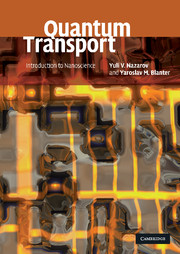Book contents
- Frontmatter
- Contents
- Preface
- Introduction
- 1 Scattering
- 2 Classical and semiclassical transport
- 3 Coulomb blockade
- 4 Randomness and interference
- 5 Qubits and quantum dots
- 6 Interaction, relaxation, and decoherence
- Appendix A Survival kit for advanced quantum mechanics
- Appendix B Survival kit for superconductivity
- Appendix C Unit conversion
- References
- Index
4 - Randomness and interference
Published online by Cambridge University Press: 05 June 2012
- Frontmatter
- Contents
- Preface
- Introduction
- 1 Scattering
- 2 Classical and semiclassical transport
- 3 Coulomb blockade
- 4 Randomness and interference
- 5 Qubits and quantum dots
- 6 Interaction, relaxation, and decoherence
- Appendix A Survival kit for advanced quantum mechanics
- Appendix B Survival kit for superconductivity
- Appendix C Unit conversion
- References
- Index
Summary
This chapter treats quantum interference effects in disordered conductors. We have already discussed interference phenomena for the few-channels case in Section 1.6, and in Chapter 2 we have seen that the scattering approach becomes increasingly complicated for many transport channels. This is why we need special methods to treat many-channel diffusive conductors. Some of their properties can be understood if we replace the Hamiltonian or a scattering matrix by a random matrix. In Section 4.1 we discuss random matrices as mathematical objects and review the properties of their eigenvalues and eigenvectors. We then use random matrix theory to describe the properties of energy levels (Section 4.2) and transmission eigenvalues (Section 4.3).
To describe interference effects in a very broad class of conductors, we develop in Section 4.4 the methods to handle interference corrections for a circuit theory, which allows us to take account of all nanostructure details. We evaluate universal conductance fluctuations and the weak localization correction to conductance.
We also find that, in some situations, electrons are localized – confined to small regions of space. Section 4.5 discusses under which conditions this strong localization occurs and briefly outlines transport properties associated with this regime.
Random matrices
In this section, we describe disordered and chaotic systems. Disordered systems contain some defects that scatter electrons; chaotic ones do not have any defects, but scattering at the boundaries induces a very different motion for particles with very close energies. In these systems, the positions of energy levels and transmission eigenvalues are random and vary from sample to sample. We have already encountered such a situation when discussing the transport properties of diffusive conductors in Chapter 2.
- Type
- Chapter
- Information
- Quantum TransportIntroduction to Nanoscience, pp. 299 - 373Publisher: Cambridge University PressPrint publication year: 2009



